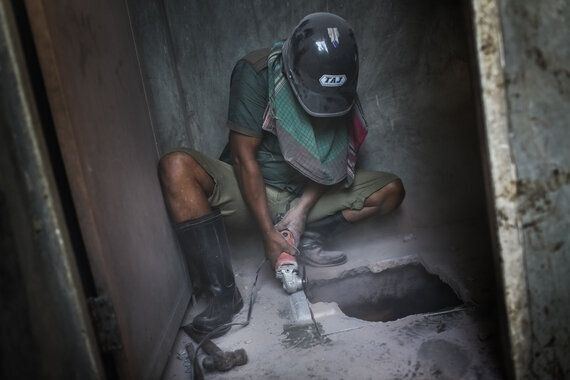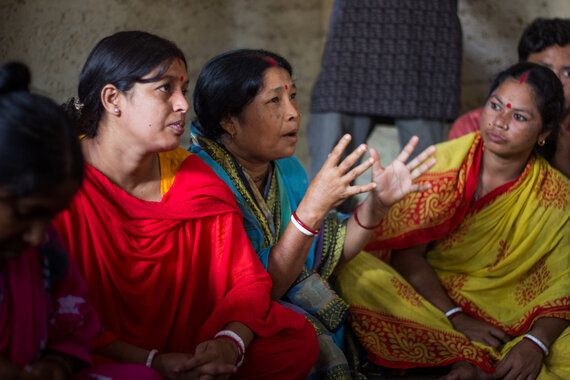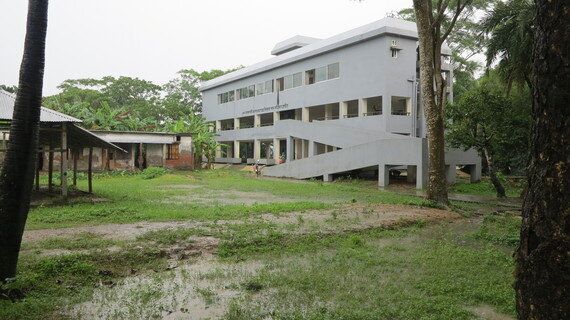
Since the 1970s there has been an explosion of organisations with a vision to improve lives within the international development paradigm. But how effective is charitable work that cannot be measured in the ways needed by the very people who fund it? To find out, I meet the two-man team of the architecture charity AzuKo, who explain the myriad of challenges they face as a small organisation pioneering public interest design.
In an endangered language of the Democratic Republic of Congo, the word AzuKo means 'all of humanity'. The organisation that wears its name strives to empower disadvantaged communities through human-centred design and its Director, Jo Ashbridge believes that while good design can improve lives and should be accessible to all, it rarely is.
Jo has just returned from Bangladesh, where AzuKo are designing a sanitation facility with a community where improved water and hygiene had been raised as an urgent need. At the heart of AzuKo's practice is a culturally sensitive approach that works with communities globally to improve their lives, rather than for them. Jo explains:
'We have to work with them to define exactly what improving their living conditions means. We would never embark on a local project without a local partner. It is important to have this for trust and to understand those nuances of culture and traditions.'

Supporting local communities to improve their own environments, begins with asking the people directly as opposed to a top-down approach. Nathan Ardaiz, AzuKo's Research Associate says that we must 'start on the ground with the people that we are designing for'. It is crucial to 'not just fly in design solution, but invest time living, working and speaking to local communities before embarking on anything', he continues.
This process of community integration is called immersion, which Jo describes as, 'essentially having loads of cups of tea with people', and can take three months to a year - living and operating in the project's context for the entirety of the project.
Functioning holistically entails designing something based on the entire experience of the community. Nathan describes how working on a play space for a primary school in Bangladesh in the same area as the slum for instance, encompassed gaining an understanding of how the children move to and from the classroom, how they engage with their teachers during class time and how they play outside, all in order to integrate the experience of play with the experience of the classroom.
Do too many NGOs spoil the international development field?
While AzuKo's method is conscious to avoid locals seeing their work as unwanted Western influence, inevitable challenges arise as a result of the over-saturated non-governmental organisation (NGO) field. Jo explains:
'People are constantly being interviewed and demographic data is constantly being taken. This is something you see happening all over, including where we are working in Bangladesh; people have been surveyed for the tenth time with the same questions, and because a lot of organisations don't share what they're doing, you get this repeat. It's their lives that we are stepping into and what right do we have to do that, apart from having good intentions?
'We want as much information as possible to co-create the solutions. But we follow everybody else that has been in that community, so we are already pre-judged before we get there by the other white-face that entered the community, how they operate and how they interacted with communities. So you've got to unpack all of that before you can even start.'

This dignified process of implementing culturally conscious, community driven initiatives sounds admirably ethical, but evidencing that it effectively leads to sustainable development is proving to be a great obstacle because the impact is in a community's social and mental changes, as opposed to statistics.
The power of anecdotal data
Demonstrating the value of changing a community's mindset through storytelling rather than statistics, is what AzuKo is convinced makes anecdotes the real data that can make a difference. But Jo explains why this is so tricky:
'It's easy to prove your impact if your mission is to provide tens of thousands of mosquito nets to a community. But to show how you've built the capacity of the community, or how people have changed their viewpoint and now interact with their neighbours - it's so valuable, but so difficult to prove.
'We don't necessarily always result in a built solution so when people hear "architecture charity" they want to see a nice shiny school in a rural African village. Some of our projects aren't sexy and they're below ground; I can't take a picture of the drainage solution that we've built, but it's what the community needed'.
Nathan compares the difficulty of trying to communicate that this process is the best way forward within a capitalist paradigm, to 'trying to fit a square into a circle'.
'It takes patience, time, listening, respect - things that are not incentivised by our current system,' he continues.

AzuKo's project in the Jogen Babu Maath slum in Bangladesh is exemplary of this. Jo has been working with the community on a personal level since 2010 but the impact it has had, she explains, is not quantitative:
'We aren't an organization that provides a thousand houses for those without residence. We are an organisation that works with communities to develop their vision for the future and incrementally co-create there.
'It's taken us six years to get to this point where we are building a very modest sanitation facility where a minute portion of an urban slum which is only one of many in that city and hundreds in the country itself.
'If you're going to ask us what metrics we have and what's our impact, it's quite difficult for us to put those hard stats on the table. But I would love to be able to take you there and show you the changes that have been made over the last six years.
'For example when we started with the community in 2010, it was very difficult for us to hold a community meeting. It was always end up within the first 10 minutes an argument, even a physical fight. Now, we have a democratic committee that we support through an election. We sit down once or twice a week with that group to discuss issues within that community. That for us is a huge change in mindsets and mentalities in lower income areas.'

Within a Muslim, patriarchal society in Bangladesh, Jo has helped to bring together a democratic design committee with almost half of its voices being local women. The committee has dictated what they want to work on, which feeds back into the community in order to develop ideas around sustainability. Nathan asserts the importance of the locals being able to manage their designs, adding:
'They have to come up with processes and ways to make sure that these things continue to work when we're gone. That's the point of sustainable design. But you'll never be able to measure that impact.'
Unsustainable sustainable development
When real sustainable work is not built on the basis of quantitative metrics and can't provide 'sexy impact infographics' as Jo calls them, it means budgets are tight for AzuKo as investors are apprehensive. But it does not stop the team of two from diversifying from working on small-scale independently driven projects, to consulting major organisations like the World Bank. This, Jo and Nathan believe is where huge impact can be made because it allows their core insights and ethos that goes with it, to be scaled-up. But the issue arises when big organisations with good intentions don't take the right advice, which can lead to doing more harm than good.
In 2015 AzuKo was brought on as a consultant by the World Bank to undertake a human-centered analysis of their cyclone shelter programme, which is currently being delivered in conjunction with the Government of Bangladesh as part of their wider disaster-relief programme. At the time, approximately 180 cyclone shelters had been completed, with another 250 in the pipeline. Each of these multipurpose buildings were to act as a place of refuge pre, during and post disaster for between 1500-2000 vulnerable people. Although Bangladesh stands as one of the world's most disaster-prone countries and is particularly susceptible to cyclones and floods, these shelters were largely not being used by Bangladeshi locals.

With the support of their Bangladeshi partner organisation, AzuKo visited existing shelters to conduct site surveys, interviewed communities in the catchment areas, held female only focus groups and brought together building management in an effort to understand the reality on the ground and provide recommendations for design, maintenance and operational improvements. AzuKo's insights centered around making improvements to surrounding road infrastructure and water, sanitation and hygiene facilities, alongside consideration of accessibility and fire safety in light of extremely high occupancy during a disaster.
After AzuKo presented its recommendations to the group in order to help guide the design of 250 further shelters, the World Bank commissioned a second review, without the help of independent or local consultants. Consequently, very little change has been implemented.
On 29 November 2016, Jo took to the stage at a 'FuckUp Night' in London for Giving Tuesday, to discuss this particular case study. Reflecting on the event, she says:
'I questioned my impact, that of AzuKo as a small grassroots charity operating at such a scale, and that of the implementing organisations: was bringing AzuKo on simply a tick box exercise for them?'

Bureaucratic box-ticking exercises are a growing notoriety in the era of NGOs and Corporate Social Responsibility (CSR) quotas, as it not only puts into question the authenticity of goodwill, but ultimately limits development potential - as well as causing potential detriment.
While challenging large-scale, unsustainable sustainable development is perhaps too great a giant for a small grassroots organisation like AzuKo at this point in time, their small-scale independently led projects are pioneering in the field of public interest design. Their projects are slowly but surely paving a convincing path that demonstrates the power of making a difference using storytelling, despite it being in contradiction to the quantitative evidence demanded by corporate investors with charitable interests.
AzuKo wholeheartedly believes in trans-disciplinary designs that incorporate not just the architect, but the economist, the political head, the local artist and most importantly the end-user round the table from the very start of the process. After all, human-centered design must prize the beneficiaries at its heart, which is why AzuKo holds trust, respect and understanding as fundamental to the design process. For only with this holistic approach, can all of humanity benefit from sustainable design.
Photo credit: Turjoy Chowdhury & Elicea Andrews
